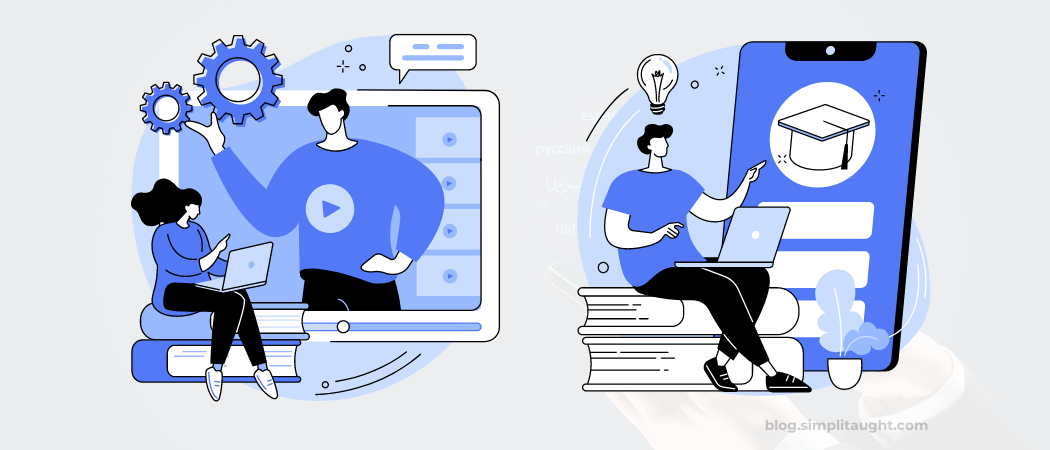Mobile learning has recently gained significant popularity due to its widespread use and technological advancement along with mobile learning challenges. It has revolutionized how we learn by breaking down traditional challenges of location and time. With mobile learning, students no longer need to sit in physical classrooms or be limited to fixed schedules. Now, they can engage in learning activities on the go, during commutes, or even in their free time.
Although it offers many benefits, the challenges of mobile learning in education must also be addressed. So first, let’s dive into what constitutes mobile learning.
What is Mobile Learning?
Mobile learning, also known as m-learning, is an educational form that uses mobile devices, such as tablets and smartphones, to facilitate education and deliver learning content. It leverages the portability and convenience of these devices to offer students access to learning resources, materials, and other interactive activities anywhere and at any time.
Why is It Important?
Mobile devices have increasingly become affordable and accessible. Hence, it has made mobile learning available to a wide range of learners. It breaks down barriers to learning by reaching people who may have limited access to traditional learning resources or face geographical challenges. Mobile learning empowers students in remote areas, those unable to access physical classrooms for various reasons, or individuals with learning disabilities to get an education whenever and wherever they want.
Likewise, mobile learning enables students to access educational content anywhere and anytime, providing convenience and flexibility. Individuals can engage in learning activities at their own pace and fit education into their busy schedules. Whether waiting in line, during commutes, or in their free time, students can use mobile devices to pursue their learning. This flexibility fosters lifelong learning and accommodates diverse learning preferences and styles. Check what NIH has to say about mobile learning and the barriers to it.
Benefits of Mobile Learning
Before looking into the challenges, let’s explore some of the benefits of m-learning.
Diversifies Learning
Mobile learning can diversify learning. Alternatively speaking, you can quickly deliver learning in various ways to students – including webinars, microlearning, face-to-face workshops, and online courses.
Microlearning which refers to providing bite-sized learning content, is extremely popular and has endless benefits. Likewise, this online education trend is a perfect fit for mobile learning. Students can easily acquire knowledge with short modules through their mobile devices.
Enhances Course Completion Rates
Another benefit of mobile learning is that it helps institutions and educators achieve better course completion rates. We are in an age where time and convenience are an essential factor for everyone. Thank goodness for mobile learning.
Because students can access course materials anywhere and anytime, they can now learn on their own terms and schedules. Additionally, giving students access to e-learning content helps to facilitate successful course completion.
Improves Knowledge Retention
Mobile learning is vital in boosting the knowledge retention ability of students. For example, using short videos for your mobile learning content can help students retain and recall information easily and quickly.
Mobile Learning Challenges & How To Overcome Them
Now that we know the advantages of mobile learning, here are some of the challenges of m-learning that educators and students should be aware of.
Content Compatibility
A challenge that you will likely encounter with m-learning is content compatibility. More often than not, when instructors or institutions create content for e-learning purposes, students may experience trouble accessing it on mobile devices. Therefore, educators might need to exam the content tools they use in order for students to successfully access content on smartphones – which can be both time and effort intensive.
The right configurations to access content on mobile devices may differ, so educators may need to create content in various formats that caters to a wide variety of students.
Educators can overcome such challenges like these by prioritizing resources and platforms that use responsive designs. Such designs ensure that the learning content automatically adjusts its formatting and layout based on the device’s resolution and screen size. It enables students to access content seamlessly across different mobile devices. In addition, educators may need to consider other factors such as touch navigation, limited bandwidth, and screen size.
Another helpful hint to remember when creating content is that smaller font sizes are less readable on smaller screens, complex layouts are simplified, and mobile-friendly features like swipe gestures may be limited. Educators can also incorporate various types of media, such as videos, audio, interactive videos, animations, etc., optimized for mobile learning for better outcomes.
Data Privacy & Security
In case you’re considering mobile learning, data privacy and security concerns should definitely be evaluated. No need to fret – there are ways to help you deal with these issues. An important thing to keep in mind is that online training programs tend to expose sensitive information regarding the company and its learners to the outside world.
One way to negate the above stated scenario is to check for vulnerabilities in your server and address them. Furthermore, you may also make it compulsory for all learners to install a certain antivirus program before accessing the training program.
Small Screen Sizes
Mobile learning poses another challenge, i.e., continuously reading learning materials on small screens may hurt your eyes. However, you can easily overcome this issue as many solutions are available. For example, you can use Virtual Reality add-ons or ensure that learning content is as short as possible to reduce the viewing time of students.
Final Thoughts!
Despite its challenges, mobile learning promises to increase the effectiveness of online learning programs. So, if give students an opportunity to learn in a way that better fits into their lifestyle and reduce the burden on educators, mobile learning is the answer for you. Nonetheless, you need to be knowledgeable about security threats and other issues. Be prepared to invest in addressing these issues in order to get the best learning experience and outcomes for your students.








